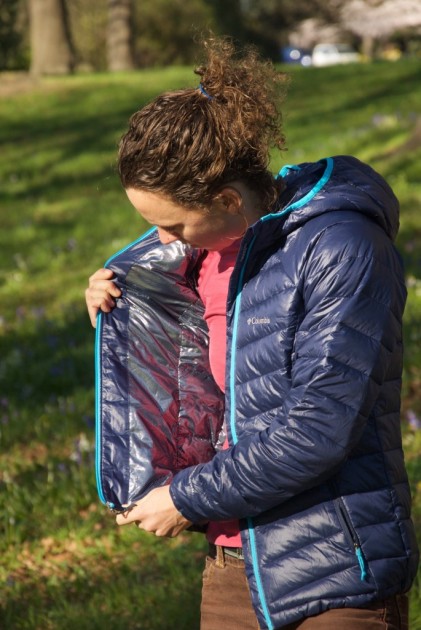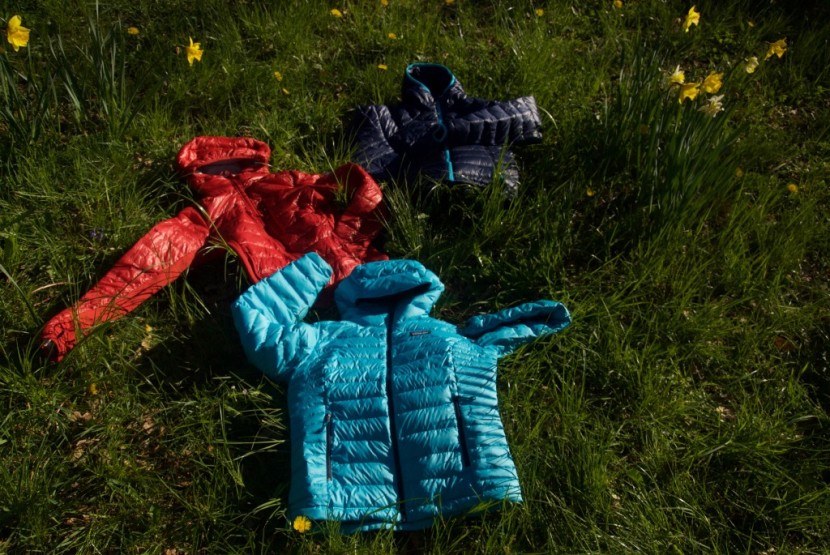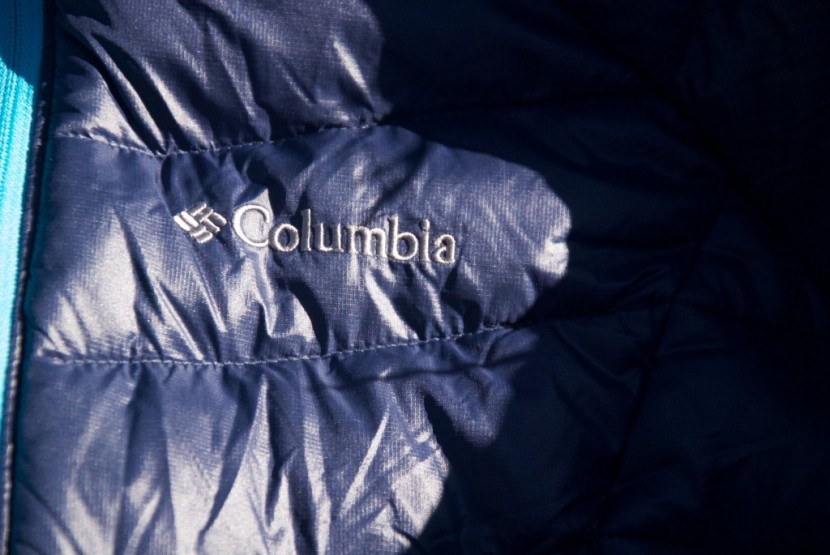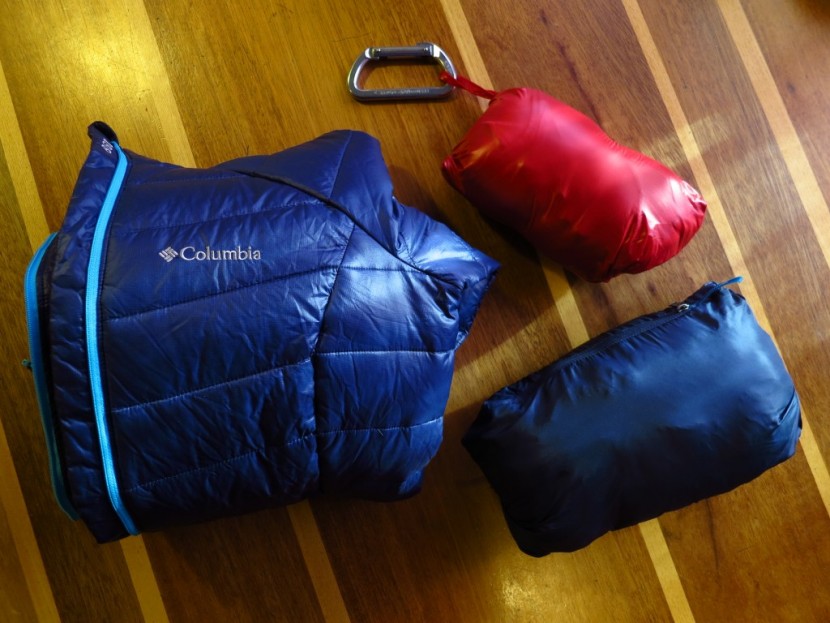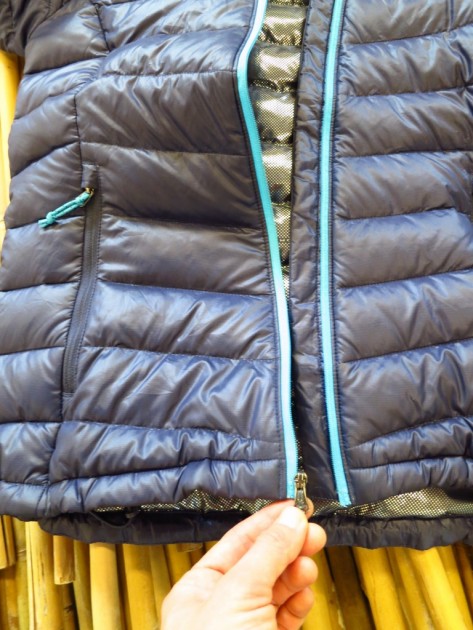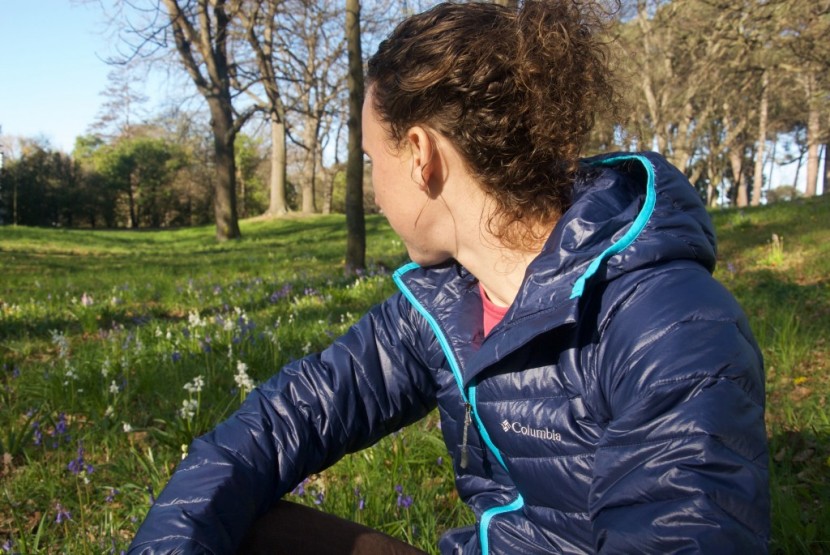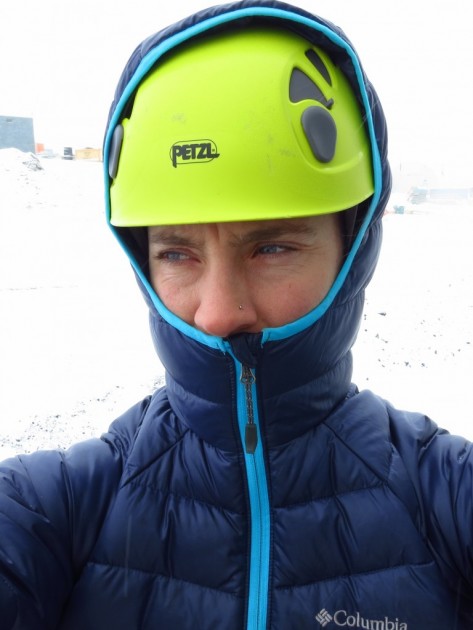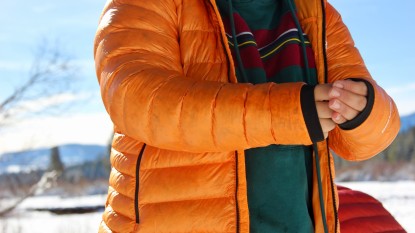This wins our Best Buy award because it scored in the middle of the pack for a fraction of the cost of the other award winners. It does have some drawbacks and we don't recommend it if you are especially active outdoors as it does not breath well. However, if you just want a jacket that performs solidly overall, is warm, and can often be found for under $120, this jacket is a great buy.
The Omni-Heat lining sounds like a great idea, and makes for a strong selling point: Columbia claims to have made their down jacket even warmer by essentially putting an emergency blanket on the inside (really, it just looks like a bunch of silver dots painted inside). It does succeed in adding warmth, but mostly at the wrong time: when you are on the move and generating enough heat. Instead of dumping excess heat, the jacket reflects your own heat back to you, which made us sweaty and swampy and generally unhappy. This jacket is relatively affordable and looks sleek enough to dress up for the office, but we can't recommend it for extensive active use.Columbia Platinum 860 Turbodown Hooded Jacket - Women's Review
Our Verdict
Our Analysis and Test Results
Hands-On Review
New technology and bold assertions are low-hanging fruit for the reviewer. Especially when a new product claims to have improved upon a technology possibly as old as the dinosaurs: down feathers. We plucked Columbia's new Platinum 860 TurboDown jacket from the shelves as soon as we heard about the use of their proprietary Omni-Heat reflective lining. The concept, at first, sounded brilliant--like an idea that had been hiding in plain sight, only to ripen upon thinking of it. In our testing, the concept worked--but not in a way that is practical to the outdoor enthusiast.
The liner would reflect heat back as advertised, but it needs heat in order to do so. Rather than maintaining the heat generated, like traditional down jackets, the Omni-Heat material would increase its heating power as you are producing it. This means that as you quicken your pace and generate a little heat, the liner reflects that new warmth back to you, making you feel exponentially warmer from the reflection of the jacket at the very same time as you are generating your own body heat. The result is the sweatiest, stuffiest down jacket in our review.
Warmth
In a nutshell, the Columbia Platinum 860 TurboDown hooded jacket is plenty warm--but it becomes too warm at the wrong time. The effect of the Omni-Heat reflective lining is cyclical: as you generate heat, it reflects that heat back to you, making you warmer and warmer until finally you start to sweat. Without this liner, down jackets will allow your body to dump excess heat, so when you jog across the street, or make a few difficult turns down the ski slopes, you don't suddenly find yourself swampy inside your jacket with steamed-up sunglasses because the only way for that heat to escape was up through your collar.
Additionally, the reflective lining did not add any warmth as we got cold in the jacket: without excess heat to reflect, it has nothing to work with.
So, warm? Yes. Functional? No. When we were cold, it did not kick in to make us warmer (that technology would be pretty amazing, though probably gas- or battery-powered), and when we were warm, it exacerbated our heating to the point of sweating.
Weight
Nowhere online could our reviewers find an officially stated weight for the Platinum 860 TurboDown, but our scales show 16 ounces. It is not a lightweight, compressible jacket you'd be super stoked to cram into your backpack. Synthetic insulation and rugged outer fabrics add some heft to this jacket.
Water Resistance
The outer material of the TurboDown is very rugged and highly water resistant. This comes at a cost to comfort, as the hand is not as soft and supple as some less water resistant materials. The jacket feels stiff, but it is rugged and weather resistant.
Columbia touts its mixture of 60 grams of Omni-Heat synthetic insulation and 800 fill goose down as “performance-enhanced down” which provides “ultimate lightweight warmth and heat retention, even when wet.” The water-resistant shell fabric never gave us opportunity truly to experience the insulating capabilities of their hybrid down when wet--and we imagine lest we wear this jacket in a torrential downpour without a rain jacket over it, it is a feature we are not likely ever to utilize. In reality, combining down and synthetic insulation just makes the jacket heavier and less compressible than other down jackets.
Compressibility
The TurboDown is among the bulkier jackets in our review. The rugged outer material and Omni-Heat liner contribute to the bulk, but the jacket also includes 60 grams of Omni-Heat synthetic insulation in addition to the 800 fill goose down, making the insulation also more bulky.
Our reviewers did not see any benefit to the synthetic insulation, except that since we were more likely to sweat in this jacket, it was probably more likely to get damp than other jackets in our review, and the synthetic insulation will, theoretically, keep you warm even when it is wet. But then again, the materials were quite water resistant and not very breathable, so our sweat seemed less likely to get into the insulation in the first place. But that is all getting very complicated. Getting back to the basics of what we like in down jackets: was it light and compressible compared to other similar jackets? No.
Style
The stiffness of this jacket resulted in a minimally flattering, androgynous fit. This jacket will “dress up,” however, unlike the Patagonia Down Sweater Hoody - Women's which has a much more casual look.
The raglan style sleeves provide good fit and range of motion for the shoulders. The outer fabric of the TurboDown is more resistance to staining, and so will look professional for most of its life. The zipper has smaller teeth and a reversed orientation so the flat side is showing. This makes the jacket look more city-savvy.
Durability
Our main complaint regarding durability is the zippers. Right out of the box, this jacket was difficult to zip up and unzip: it wouldn't align easily to zip closed, and would catch on the bottom every time we went to take the jacket off. The small zippers tend to be less durable, in our experience, as all of the parts are easier to bend and/or break. Columbia also decided to reverse the orientation of the zipper entirely. Examine the main zipper: it looks flat, tidy, lending a professional look to the jacket. Flip to the inside of the jacket and you will see zipper teeth that protrude. Because we tend to pull out on our zippers when we zip and unzip, this orientation grinds on the wrong side of the zipper's teeth, and in our many years of wearing, using, and abusing zippered garments and gear, these zippers have been the first to fail.
Features
The TurboDown jacket is simple and basic. Nothing extraordinary in the features department, and a few minor flaws. The cuffs are soft elastic, very nice and simple. The hem has a nice draw cord. But the hood is not adjustable and rides high, stopping well above the forehead. It is quite snug around a helmet.
No niceties like fleece patches around the neck where the jacket touches your chin. It is a simple jacket, and while we often like simple things, in this review, that descriptor carries the weight of design flaws and disappointments.
Best Applications
This jacket would be acceptable for around town use, given its sleek and professional look. We cannot recommend it for outdoor pursuits due to the issues with overheating and zipper overuse, as well as its comparative bulk and heavier weight.
Conclusion
If all you need is a relatively warm, inoffensive, cheap down jacket to sport minimally around town, this jacket will meet your needs without disappointment. The misty winter cities of the west coast come to mind as a good audience for this jacket: Seattle and Portland for sure, and for some, like Mark Twain, that might include summers in the Golden Gate. After all, he once said, “the coldest winter I ever spent was a summer in San Francisco.”




